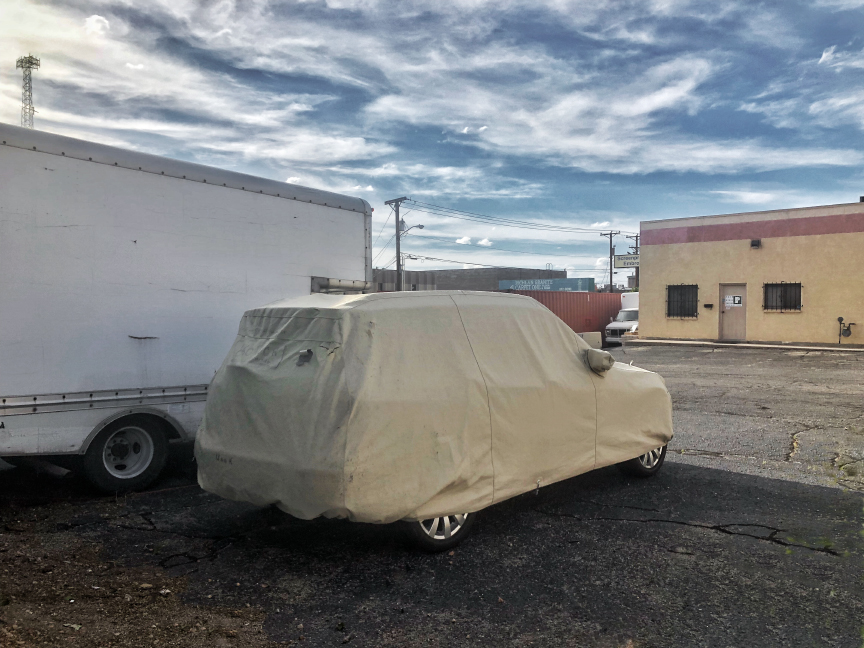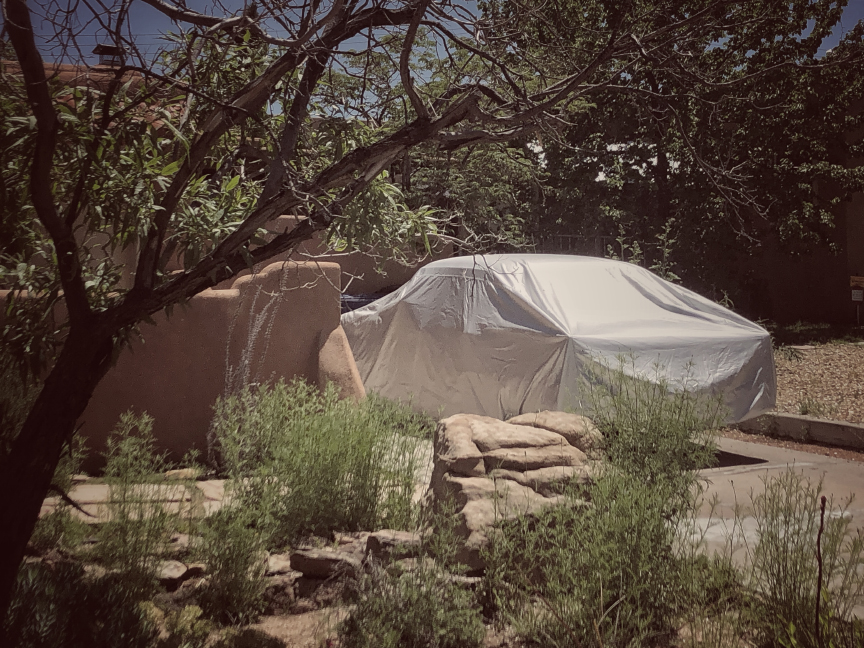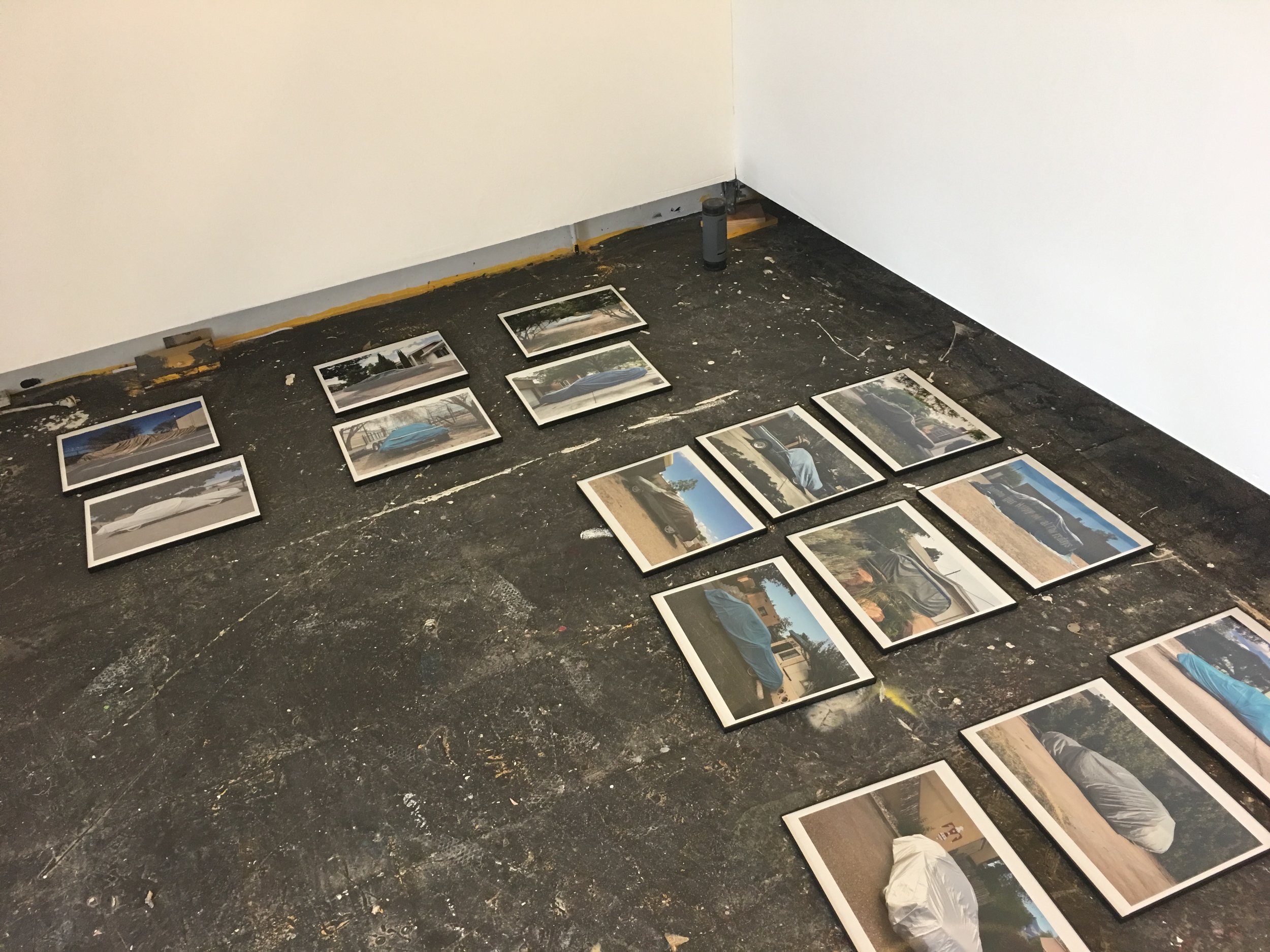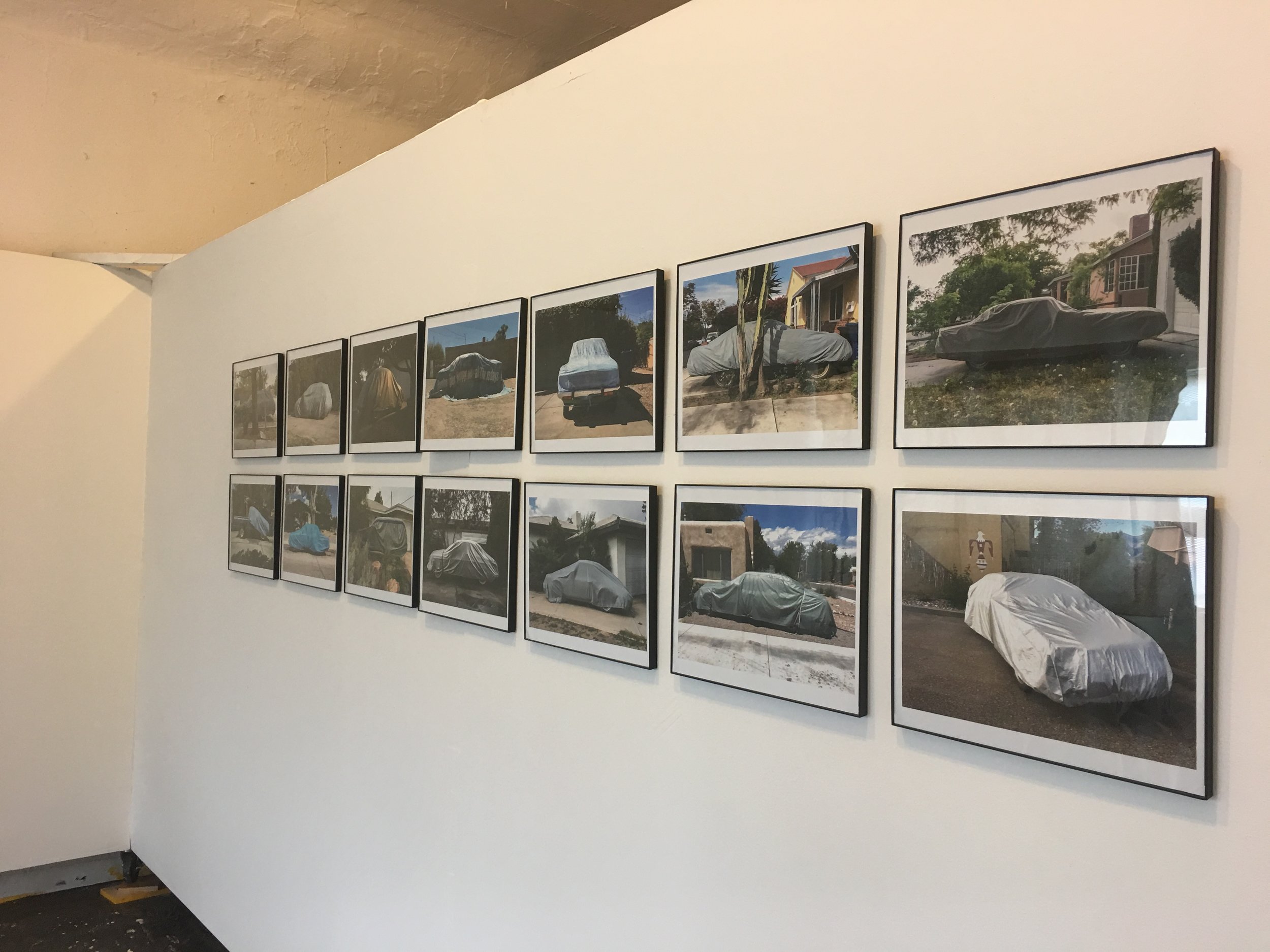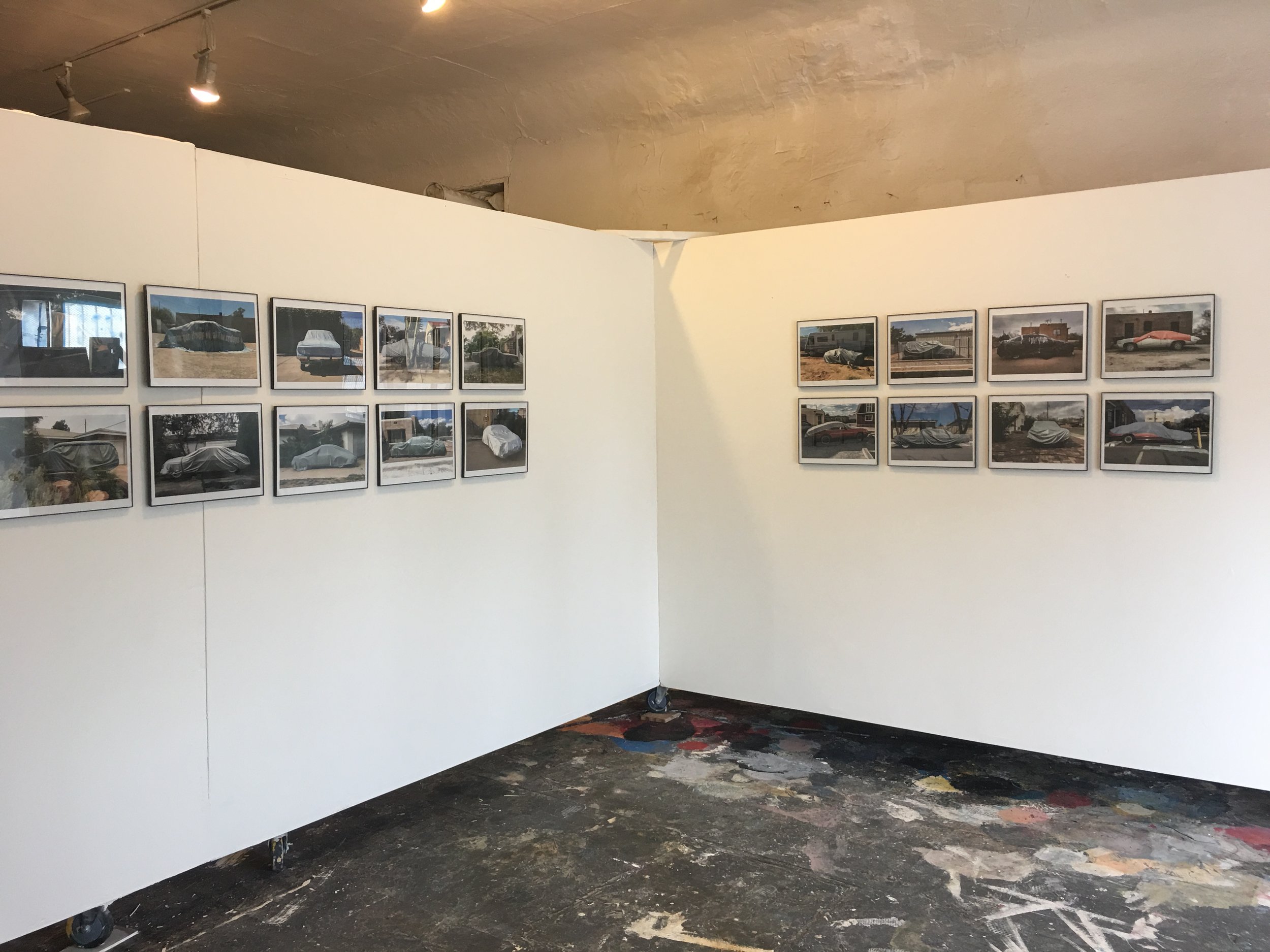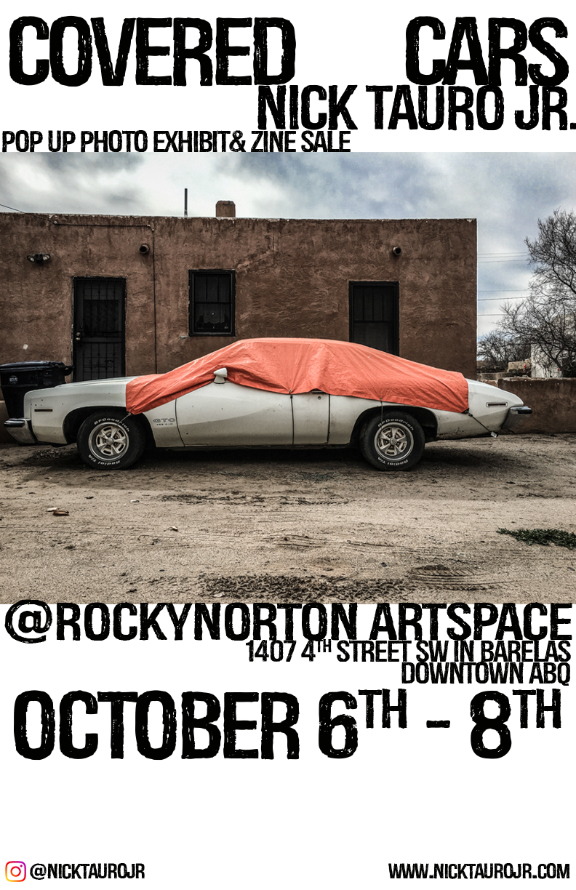Sometimes work life gets in the way of personal life. This was one of those weeks. In the interest in keeping up this weekly blog posting, I’m at least sharing a few images I made while focussing on a TV production. Long hours in prep and two 12 hour days on set left little time for anything else. I did find a few covered cars out in the field, so not a total disengagement from my personal work. See you next week.
Covered cars remain an obsession for me; serial photography has its rewards.
2019: 17 (Holding Pattern)
After a chill Easter weekend in Santa Fe, I guess my body rebelled against too much rest and relaxation and I ended up getting a wonderful, early Springtime cold. This one has been stubbornly holding on for the past four days, and my frustration continues to mount.
In the meantime, it’s giving me time to stop and reflect on what might come next for me, photographically speaking. I have a few ideas for new projects, but nothing concrete, and a couple of these ideas will push me out of my comfort zone for shooting. I’m also sitting on about 15 boxes of Fuji peel-apart film for my Polaroid 360, and once that film is gone, it’s gone. Since it’s been discontinued, I just can’t justify paying $50 per box on Ebay. At the same time, I’m struggling to come up with a worthy project that will do justice to the unique quality of that film. I’m open to suggestions, dear readers.
I’m trying to be patient and ride out this “in between” time, as I know I’ve been on a tear creatively for the past year or so, so time to breathe is welcome, even if it’s through clogged nasal passages.
Covered Cars Exhibit and Zine Sale This Weekend
If you are in the Albuquerque area this weekend, I cordially invite you to see my series "Covered Cars" which will be exhibited at Rocky Norton's Artspace, at 1407 4th Street SW. This is a three day only, pop up event. I will have thirty framed photos on display, available for purchase at a special price of $50 each. I will also be selling a limited edition, signed zine of the series, for the price of $5 each. Hours for the event will be Friday evening, from 6 pm to 9pm, and both Saturday and Sunday afternoons from 12 Noon until 4pm. I am grateful to Rocky for opening up his studio space for this event. I hope to see you there.
“In a culture that was built upon and continues to idealize the automobile, I am drawn to these vehicles that are, for one reason or another, shrouded. To me, they convey a combined feeling of holiness, of sadness, and of secrets and stories kept hidden.”
Photograph © 1958 by Robert Frank
Worth A Thousand Words: Robert Frank
Up to this point, I’ve been hesitant to write any words about Robert Frank, for a number of reasons. Most of them are rooted in my deep love of his work and the profound influence he has had on my own image making. How do I pay due respect to an artist so important to me? Can I be objective when writing about a particular image of his? Another challenge would be deciding which of his images would I focus my attention on? There are just too many touchstone Robert Frank photographs to choose from. Nonetheless, with a looming exhibit of my own, it made sense to try to write about this week’s image “Covered Car, Long Beach, California.”
So, what do we see in this photograph? It is a car, covered in some kind of white fabric. The car is parked between two thick palm trees. Shadows from the trees are cast upon a plain looking, boxy building, the wall of which look covered in a dark stucco. The light seems like late afternoon to me. The composition is slightly off kilter, just slightly tilting to the right. The fabric that covers the car has an almost striped appearance to it, the result of bands that are stitched together. The contrast is somewhat stark, with the white of the cover offset by the deep shadows on the wall, and the tufts of palm leaves on the trees. All in all, a fairly non-complex photograph at first glance.
What is not seen in the photo? Well, this is an urban environment, but there are no people seen in the shot. And we of course assume there is a car under the tarp, being able to recognize the shape of the chassis, and the distinct poke of an antenna pushing up the covering as well. The next question I ask myself is why did Frank take this photo? It appears in his seminal book “The Americans” which creates a context for a deeper interpretation of the image. Frank explored the subject matter of the automobile extensively throughout the book. When Frank was shooting the photographs that eventually became "The Americans," the automobile was seen as a key component to the post-WW2 westward expansion in the United States, and was a symbol of freedom and mobility for a growing middle-class society. The fact that the car is covered brings what seems to me an elegiac quality; quite a mournful feeling to this image. Coupled with the fact that the lighting indicates late in the day, nearing sunset, I get a distinct feeling that there is an intrinsic sadness to this image. The car becomes a body covered, something to be mourned, hidden, and prepared for some kind of death. Of course, this is my personal projection on to the image, but if an astute viewer were to look at the photo in the context of where it appears in “The Americans” one would make a similar leap.
The image appears in a sequence of the book that begins with a close up, side view of two men in the front seat of a car, “US 91, leaving Blackfoot, Idaho.” Here we see the car as a means of escape, with Frank a passenger in a very tight front seat with two mean who look as though the are fleeing a crime scene. Next is an image of five elderly people sitting on a roadside bench, titled “St. Petersburg, Florida.” In the background, we see a car speeding by, slightly blurred. Is this a rumination on death, the life that is soon to be leaving these people speeding behind them as they wait for the inevitable? The “covered car” photo is the next image in the sequence. The photo that then immediately follows shows the aftermath of a car accident, with a group of four people standing beside the blanket covered remains of what is surely a dead body. The covered body echoing the covered par in the previous image. To complete this run of images, we see a long view of a lonely highway in New Mexico, stretching off into the far distance, with just a lone car driving towards us, seen very far off in a dark, foreboding environment, under a threatening sky. Seen as a whole, this sequence of images tells a sad story of life and death intertwined with the presence or influence of the automobile.
Photograph © 1958 by Robert Frank
My own fascination with covered cars stems directly from the image made by Robert Frank. My approach to the subject matter is quite different. For one, I chose to show the cars in color. I have taken a clinical, studied approach to the subject matter, and have assembled well over fifty of such images, to date. I am fascinated when I look at them as a group of photos, when the variety of covers and locations become a foil to the consistency of the subjects. Yet, there is still that initial feeling of sadness that permeates the images I make. These vehicles are covered for reasons I don’t ever really know. Are they classic cars that require protection from the elements? Are the windows busted and leaking, requiring covering to protect the interior? Is the vehicle evidence of some crime? Has an accident occurred? They often look like Christ-like bodies, covered in shrouds. Or perhaps they represent something desirable yet hidden from view, their covering providing a layer of mystery and intrigue.
It is amazing to me that so many of these covered cars reveal themselves to me as I travel my home city, but also in locations that I travel to. They seem to be everywhere once I start looking for them. They serve as a constant reminder of the influence that Robert Frank has had on my work, and send a silent message of kinship and solidarity to me as I pursue my work. As the master has said, “The eye should learn to listen before it looks.” I am constantly listening and looking, too.

